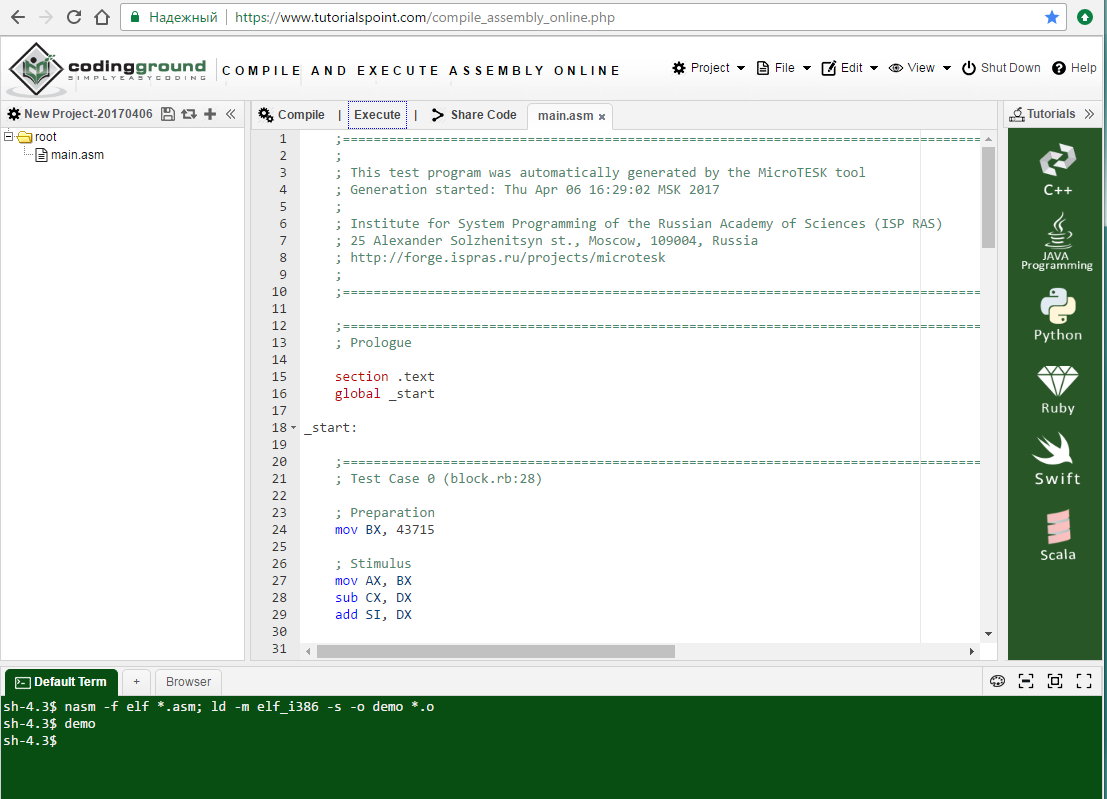Getting Started with x86 » History » Revision 77
« Previous |
Revision 77/87
(diff)
| Next »
Alexander Kamkin, 04/06/2017 08:32 PM
Getting Started with x86¶
Prerequisite¶
MicroTESK should be installed.
Demo Specifications¶
Specifications of the x86 (8086) instruction set architecture (ISA) can be found in $MICROTESK_HOME/arch/demo/x86/model/x86.nml.
Instruction are described in nML by means of the following constructs (move r16/r16 is taken as an example):
- the signature
op mov_r16r16 (dst: R16, src: R16) - the assembly format
syntax = format("mov %s, %s", dst.syntax, src.syntax) - the binary encoding
image = format("1000101111%s%s", dst.image, src.image) - the semantics
action = { dst = src; ... }
To compile the ISA model, run the following command:
sh $MICROTESK_HOME/bin/compile.sh x86.nml
Demo Templates¶
Test templates for the x86 (8086) ISA can be found in $MICROTESK_HOME/arch/demo/x86/templates.
The directory contains a number of demo templates including the following ones:
| block.rb | demonstrates how to use block constructs |
| block_random.rb | demonstrates how to create randomized instruction sequences using block constructs |
| euclid.rb | demonstrates test program simulation to predict the resulting microprocessor state |
| random.rb | demonstrates how to randomize tests by using biases and distributions |
| random_immediate.rb | demonstrates how to randomize immediate values |
| random_registers.rb | demonstrates how to randomize registers (dependencies) |
Test templates are written in Ruby extended with specific constructs (let us look at block.rb):
- the code in the beginning includes the x86_base.rb file where a base template
X86BaseTemplateis defined and declares aBlockTemplatetemplate:require_relative ''x86_base'' class BlockTemplate < X86BaseTemplate # BlockTemplate is a heir of @X86BaseTemplate@ - here is a template entry point:
def run - this block produces a sequence consisting of three instructions:
sequence { # sequence: {mov, sub, add} mov_r16r16 ax, bx sub_r16r16 cx, dx # registers: fixed add_r16r16 r16(_), r16(_) # registers: randomized }.run - this block produces an atomic sequence consisting of three instructions (atomic sequences are not interrupted while being merged with other ones):
atomic { # atomic sequence: {mov, add, sub} mov_r16r16 ax, bx add_r16r16 cx, dx sub_r16r16 r16(_), r16(_) }.run - this block produces three sequences each consisting of one instruction:
iterate { # sequences: {{mov}, {sub}, {add}} mov_r16r16 ax, bx sub_r16r16 cx, dx add_r16r16 r16(_), r16(_) }.run - this block produces four sequences each consisting of two instructions
the combinator constructs the Cartesian product of the nested sets of sequences; the compositor randomly merges each tuple of the product into one sequence:block(:combinator => ''product'', :compositor => ''random'') { # combinator: {({sub}, {mov}), ({sub}, {sub}), ({add}, {mov}), ({add}, {sub})} # compositor: { {mov, sub}, {sub, sub}, {add, mov}, {add, sub} } iterate { # sequences: {{sub}, {add}} sub_r16r16 cx, dx add_r16r16 ax, bx } iterate { # sequences: {{mov}, {sub}} mov_r16r16 ax, bx sub_r16r16 r16(_), r16(_) } }.run - this block merges two sequences in a random fashion
the combinator constructs the diagonal of the Cartesian product; the compositor randomly merges the tuples into sequences; the obfuscator reorders the sequences:block(:combinator => ''diagonal'', # combinator: {({sub, or}, {start, and, end})} :compositor => ''random'', # compositor: { {sub, start, and, end, or} } :obfuscator => ''random'') { # obfuscator: { {or, start, and, end, sub} } sequence { # sequence: {sub, or} sub_r16r16 bx, ax or_r16r16 cx, dx } atomic { # atomic sequence: {start, add, end} prologue { comment ''Atomic starts'' } epilogue { comment ''Atomic ends'' } and_r16r16 r16(_), r16(_) } }.run
To generate test program(s) from a test template (in our case, from block.rb), run the following command:
sh $MICROTESK_HOME/bin/generate.sh x86 block.rb --code-file-prefix block --code-file-extension s -v
When generation is finished, the resulting assembly code can be found in $MICROTESK_HOME.
To compile the output file, run the following commands:
nasm -f elf block_0000.s ld -m i386pe -s -o block_0000 block_0000.o
To execute resulted test cases is possible by means of the online simulator
Updated by Alexander Kamkin about 8 years ago · 87 revisions